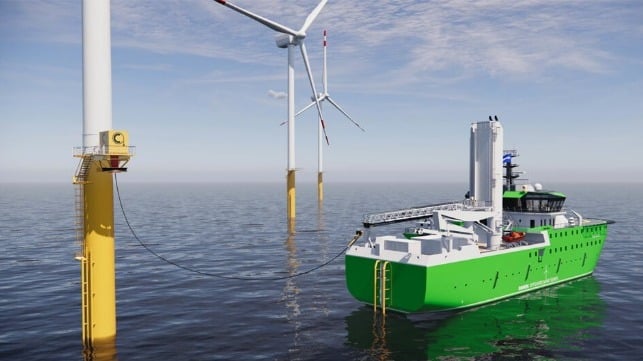Damen Introduces Design for Fully-Electric SOV with Offshore Charging

Damen Shipyards Group unveiled its latest design for a Service Operations Vessel that would operate fully on electricity with batteries and offshore charging. The shipbuilder reports after three years of study to develop the design and assess the feasibility of an electric SOV that they believe it is economically possible providing a healthy financial return on investment while also representing a breakthrough in sustainability.
The current design is for an approximately 230-foot vessel that would have 60 cabins for crew and able to accommodate up to 40 technicians as well as ample space for workshops, storage, and deck space. The vessel also features a four-azimuth thruster design to provide maximum maneuverability.
The SOV would feature a 15MWhr battery, sufficient to power the vessel during a full day of operations. The batteries would be Lithium Iron Phosphate which according to Damen increases safety while reducing the ecological footprint. For backup, emergency, and mobilization purposes, the vessel would also be equipped with two diesel generators which would permit the vessel to continue all operations, even with depleted batteries.
According to Damen, their feasibility studies showed that one of the biggest challenges to operating fully electric was the need for offshore charging capabilities. The vessel is designed with a charging system developed in partnership with UK-based MJR Power & Automation, a company that has previously developed an offshore charging system for smaller crew transfer vessels.
Charging would be carried out while the vessel is in a lower power, so-called “green DP mode,” requiring less energy than the hotel load. Damen says a full charge typically requires energy produced in just a few hours by a single turbine.
To maximize the safety and efficiency of the charging system, Damen and MJR developed a design utilizing pre-existing offshore infrastructure. The charging system would use a motion-compensated gangway to create a connection between the vessel and a turbine or offshore substation. The gangway is controlled from the bridge and requires no manual interaction with the charging equipment.
The current design developed by MJR is a 4MW charger connection which Damen reports is sufficient for the 230-foot vessel. They are also working on a scaled-up 8MW version of the charger connection which would enable charging for larger vessels up to approximately 295 feet.
“The product launch of the SOV 7017 E demonstrates that the technology is there to make offshore operations fully electric,” said Mark Couwenberg, Damen Product Manager for Service Operations Vessels. “The reduction in OPEX implied by harvesting energy directly from the offshore wind farm implies a business case for this model.”
Damen reports that it validated the case for the vessel in consultation with wind farm developers and other stakeholders using multiple scenarios. They considered the investment cost for charges and batteries, replacement of the batteries, energy costs, the price of CO2, and variations in the operating profile and required charge times.
The designs are being reviewed by DNV with Damen saying it is about to obtain Approval in Principle (AiP) from DNV. They are reporting the vessel was designed in accordance with forthcoming offshore charging standards under collaborative development with DNV UK and Norway.
